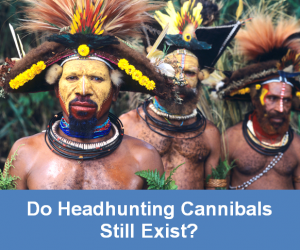 It’s a excruciating way to die. Imagine the panicked horror. Tearing through the jungle on a hot tropical island being chased by primitive men armed with sharpened stick spears, bows and arrows, and razor-edged bamboo knives. You’re viciously overpowered, savagely beheaded as a manhood trophy, then your limbs are cruelly hacked and severed from your torso which is packed off and cooked over an earthen-pit fire to be ritualistically devoured in a secret stone-age ceremony.
It’s a excruciating way to die. Imagine the panicked horror. Tearing through the jungle on a hot tropical island being chased by primitive men armed with sharpened stick spears, bows and arrows, and razor-edged bamboo knives. You’re viciously overpowered, savagely beheaded as a manhood trophy, then your limbs are cruelly hacked and severed from your torso which is packed off and cooked over an earthen-pit fire to be ritualistically devoured in a secret stone-age ceremony.
This stuff was real. This business actually occurred some time in the past. The question is — do headhunting cannibals still exist?
I watched a National Geographic Special hosted by Piers Gibbon titled Search for the Cannibals of the South Pacific. The film crew traveled to remote parts of the region of Oceania in search of the answer. What they found was fascinating. That is, if you’re curious as to whether there still are active headhunters who consume human flesh.
To start, there’s a difference between headhunters and cannibals. Not all headhunters are cannibals and not all cannibals are headhunters. I’m sure you’re aware of relatively recent North American cannibal named Jeffrey Dahmer who serial-killed gay men and ate them. Dahmer was a bit of a one-off, though. What I’m referring to is an organized culture that endorses inter-tribal warfare where men battle other men and then behead them a prized proof of manhood.
But, it’s an entirely different level to go ahead and eat them.
There’s no question headhunting and cannibalism once existed in places like Papua New Guinea, Fiji, the Solomon Islands, and Indonesia. There are historic reports of the practice in The Philippines, Borneo, and Taiwan. Then, there are primitive tribes protected in the Amazon rain forest. Who knows what they did or they do.
A very famous victim of headhunters and cannibals was Michael Rockefeller. Yes, the son of New York Governor and United States Vice president Nelson Rockefeller (also grandson of financier J.D. Rockefeller). In 1961, this entitled and arrogant young fellow thought it was a good idea to check out the natives in West Papua and see if he could collect (steal) some of their art for his museum.
That didn’t turn out so well for Rockefeller III. Here’s an account from the book Savage Harvest: A Tale of Cannibals, Colonialism, and Michael Rockefeller’s Tragic Quest by Carl Hoffman on what demise fell upon the poor soul:
 One of the tribesmen drove a spear into Michael Rockefeller’s ribs as the young man was swimming for his life. After being beheaded, his head was scalped, cut across the face from the root of the nose to the nape of his neck. His ribs were broken with an ax, his sternum ripped out, his arms and legs cut off, and entrails pulled out. Some of them were eaten straight away. The others cooked individually. A big feast for the tribe started with chanting. Then the tribesmen had sex with each other, shared their wives, and drank their urine. Afterward, they spread Michael’s blood all over their bodies and danced wildly like possessed.
One of the tribesmen drove a spear into Michael Rockefeller’s ribs as the young man was swimming for his life. After being beheaded, his head was scalped, cut across the face from the root of the nose to the nape of his neck. His ribs were broken with an ax, his sternum ripped out, his arms and legs cut off, and entrails pulled out. Some of them were eaten straight away. The others cooked individually. A big feast for the tribe started with chanting. Then the tribesmen had sex with each other, shared their wives, and drank their urine. Afterward, they spread Michael’s blood all over their bodies and danced wildly like possessed.
No, thank you.
I’m sure there’s a psychology behind taking heads and cooking humans. From what I’ve read while researching this piece is that, historically, these acts came down to animism. That’s the belief that everything has a soul or spiritual power. It seems the act of beheading a foe is to take the power stored in that being and transferring to one’s self.
And, I’m certain that ritualistic cannibalism wasn’t necessary for subsistence. You probably heard the story of the Andes aircraft crash where survivors resorted to cannibalism so they could stay alive. No, ritualistic cannibalism wasn’t about protein fulfillment. It, too, must have been some sort of power trip.
Part of my brief research into this not-for-all topic was finding an article titled Fiji: Still the Cannibal Island. It was written in 2014 by Tanja Laden who purports to have interviewed a modern-day cannibal on the island of Taveuni. Here’s an excerpt:
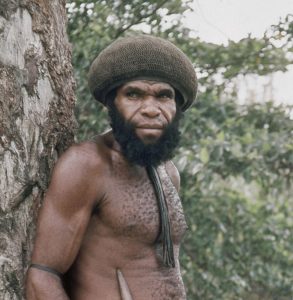 Rapuga and I sat down to discuss how cannibalism first became a ritualized practice in Fiji when European settlers arrived in the 19th century. He told me Fijians would eat people from other “races” to protect their property and as a form of revenge. When hunting down and eating their enemies, locals used a stone ax (matau vatu) and a spear (moto), along with an eye-gauger (totokia) and a sea (pronounced say-ah), which was like a brain-smasher. Then they’d eat their victims with a special cannibal fork called an ai cula ni bokola.
Rapuga and I sat down to discuss how cannibalism first became a ritualized practice in Fiji when European settlers arrived in the 19th century. He told me Fijians would eat people from other “races” to protect their property and as a form of revenge. When hunting down and eating their enemies, locals used a stone ax (matau vatu) and a spear (moto), along with an eye-gauger (totokia) and a sea (pronounced say-ah), which was like a brain-smasher. Then they’d eat their victims with a special cannibal fork called an ai cula ni bokola.
After Fijians killed their enemy, they’d drink the blood in order to become more powerful, because, as Rapuga noted, “the blood runs through the entire body.” The corpse would then be divided into portions, with the chief eating the heart and brain because everyone believed he’d literally “absorb” his enemy’s knowledge and courage. Next, a village priest would perform a ritual to one of the gods and the tribe would gather for a big celebration under the moonlight, dancing with their spears around a bonfire while the feast was cooking.
I asked Rapuga how humans tasted, and whether cannibals would serve the meat with any side dishes like vegetables. He said humans tasted like pork but sweeter, and that they’d cook the meat in an earth oven and serve it with breadfruit and yams.
Whether it’s true or not, I don’t know. But, it makes for an interesting story. It also jives with conclusions on the National Geographic Special.
So, if headhunters and cannibals still exist, who are the usual suspects? There’s a lot of information on the net that I tapped into. This material is not from personal experience, and I had no intention of making a field trip to find out. Here is another excerpt. It’s from from The Last Cannibals (5 Tribes With Dreadful Headhunting History) which sums up the situation far better than what I can write:
DANI TRIBE — “THE DEAD BIRDS”
The Central Highlands of West Papua is home to the Dani people who had been waiting a long time to be discovered. They live in so-called “honai honai”, tiny mushroom-shaped huts made out of thatch and reeds and they are hunters. Men spend most of the time preparing primitive weapons, hunting and treating resulting injuries while women look after the youngsters, grow sweet potatoes and tobacco.
 Like most of the ethnic groups in New Guinea, Dani tribe lives in its own world full of odd rites and rituals. A big part of funeral ceremonies is finger amputation of the female members for each death in a family or multiple pig slaughtering during celebrations to show the success of the community. Pig feasts and cooking rituals are a big part of every important event when several pigs are killed using a bow and arrow, portioned, wrapped in a banana leaf, and traditionally cooked in the earth oven together with potatoes and cassava.
Like most of the ethnic groups in New Guinea, Dani tribe lives in its own world full of odd rites and rituals. A big part of funeral ceremonies is finger amputation of the female members for each death in a family or multiple pig slaughtering during celebrations to show the success of the community. Pig feasts and cooking rituals are a big part of every important event when several pigs are killed using a bow and arrow, portioned, wrapped in a banana leaf, and traditionally cooked in the earth oven together with potatoes and cassava.
Small-scale warfare between villages is integral to traditional Dani culture. The emphasis in battle is to insult the enemy and wound or kill token victims, as opposed to capturing territory or property or vanquishing the enemy village. Afterward, their remains are kept for a big feast, weapons are decorated with the ornaments made out of the victim`s body and trophies such as the skull, bones, and hair are displayed in the most respected part of the village.
YALI TRIBE — “THE DWARF WARRIORS”
Sharing the territory of Baliem Valley with Dani people, less-visited Yali subgroup, only discovered in the early 60s, is known as a “tribe of dwarfs” due to their short height (150 cm on average). The access to these villages is somehow limited, not only because of their altitude of about 2,500 m but also the fact that the only way how to reach these settlements is a several-day trek through thick vegetation and rugged, steep mountains of Jayawijaya.
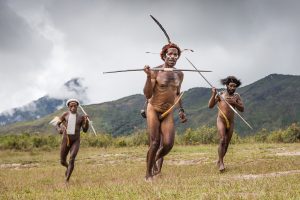 Similarly to the Dani tribe, the Yali walk around rather naked, men solely protect the most important part – their penis, using a tube-like gourd, called “koteka”, and topless women only wearing a skirt made out of grass and other natural material. Pigs are considered to bring wealth and they are only eaten on special occasions. It is quite a spectacle to see the indigenous women cuddling the snorting animals before they kill them and steam the meat on hot rocks.
Similarly to the Dani tribe, the Yali walk around rather naked, men solely protect the most important part – their penis, using a tube-like gourd, called “koteka”, and topless women only wearing a skirt made out of grass and other natural material. Pigs are considered to bring wealth and they are only eaten on special occasions. It is quite a spectacle to see the indigenous women cuddling the snorting animals before they kill them and steam the meat on hot rocks.
The Yali were also ill-famed hunters and reputed cannibals, once used to eat the flesh and brain of their enemies while still warm, grind the bones to dust and throw it into the deep valley to prevent them from returning. The region is so remote and inaccessible that even the neighboring ethnic groups rarely used to get in contact with each other. That resulted in a different development of each individual language, so the minorities of this territory often do not even understand each other.
ASMAT TRIBE — “THE HEADHUNTERS”
The tidal swampland of West Papua`s southern coast is some of the least accessible parts of the world. This is the domain of the Asmat tribe famous for their spectacular wood carvings, considered to be among the world’s finest, but more importantly for being the legendary Head Hunters.
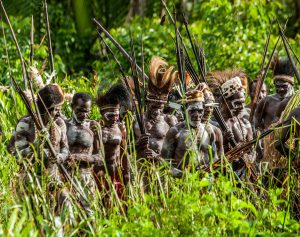 Once, in the time of war, they ate brains of their enemies mixed with sago worms – that all served on the halved skull. Afterward, they cleaned it and used it as a pillow to evoke respect and fear. They did not kill for food or not even the skull as a trophy but they worshipped the skull as a sacred object and it was believed to have special powers.
Once, in the time of war, they ate brains of their enemies mixed with sago worms – that all served on the halved skull. Afterward, they cleaned it and used it as a pillow to evoke respect and fear. They did not kill for food or not even the skull as a trophy but they worshipped the skull as a sacred object and it was believed to have special powers.
After the skull was stripped of the soft parts, e.g. brain, eyes, and skin the nasal nostrils were closed to prevent the evil spirits to enter the household were the decorated skulls were displayed. The Asmat warriors and their children would inhabit the names of enemies they had killed.
KOROWAI TRIBE — “THE TREE PEOPLE”
The Korowai are neighbors of the Asmat, occupying the inland territory of Yaniruma, near Senga and Dairam rivers. These tribes live in the tree houses built up to 30-50 m above the ground, in the rainforest clearings of the deep southern jungles.
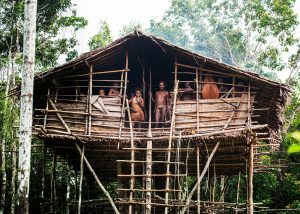 This ethnic group is to be one of the most isolated ones and believed to continue practicing rites related to cannibalism still today. The difficult access did not allow the missionaries during the Dutch colonial period to come to these areas so they could civilize the Korowai people. Those few who made it to the outlying villages were eaten or driven away.
This ethnic group is to be one of the most isolated ones and believed to continue practicing rites related to cannibalism still today. The difficult access did not allow the missionaries during the Dutch colonial period to come to these areas so they could civilize the Korowai people. Those few who made it to the outlying villages were eaten or driven away.
The Korowai are quite a fascinating subgroup and they are often called “Bedouins of Jungle” for their continuous moving from place to place in order to find food and hunt for crocodiles. They build and move their treehouses on a regular basis which makes very hard for scientists to study them. Except for a nutshell covering their penises men do not wear clothes. Women only use a basic skirt made out of sago leaves.
KOMBAI TRIBE — “THE ENDO-CANNIBALS”
The Kombai tribe is another “tree” community building their homes high in the canopy. They live in clans along the Buzza River. The closest relatives to the Korowai, they have a very similar cultural background. Men wear a hornbill head instead of the gourd and a bird beak used as a protection for their genitals. Women are traditionally in charge of making sago – the starch obtained from the sago palm tree. Pigs serve as a currency and they are sacred animals that get only sacrificed on a special occasion and cooked on the traditional earth-oven.
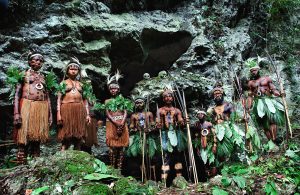 The people of Kombai still strictly hold on their ancient animist beliefs. Leadership structures are based on the quality of a strong man – and that has to be proven by their hunting skills. The Kombai used to kill their enemies for their organs and blood which were eaten and the bodies were stuffed with leaves and grass.
The people of Kombai still strictly hold on their ancient animist beliefs. Leadership structures are based on the quality of a strong man – and that has to be proven by their hunting skills. The Kombai used to kill their enemies for their organs and blood which were eaten and the bodies were stuffed with leaves and grass.
The Kombai are associated with endo-cannibalism – a ritual cannibalism within the same community. In the belief of gaining some of the qualities of the beloved person, family members would kill and eat internal organs and drink the blood of their own relatives. Totemism, black magic, witchcraft, and sorcery are an important part of their cultural heritage.
* * *
Although these five Oceanic tribes do exist and walk among us, I couldn’t find any proof that they still practice headhunting and cannibalism today. Even National Geographic couldn’t make that finding. However, the practice was certainly active in 1951 when Doctor Willem Vesser traveled with Papuan New Guinea people and witnessed firsthand what went on in their world. Here’s an excerpt from a paper titled Headhunting on the South Coast by Dr. Vesser with actual photos from the paper:
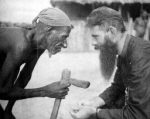 The Papuan is still a traditional savage, a cannibal who headhunts and lives in constant fear. Fear of their own kind and fear of evil spirits. An individual cannot be sure of his life from one moment to the next and there are all sorts of primitive rituals to ward off the unknown.
The Papuan is still a traditional savage, a cannibal who headhunts and lives in constant fear. Fear of their own kind and fear of evil spirits. An individual cannot be sure of his life from one moment to the next and there are all sorts of primitive rituals to ward off the unknown.
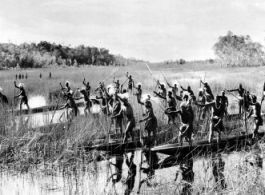 A head-hunting trip is usually a cowardly attack. The enemy village is surrounded at night. All possible escape routes are cut off, and around sunrise it is time to attack. Bamboo trumpets wake the victims who are initially paralyzed with fear and who then take off in an attempt to find shelter. But mostly they end up running straight into the head hunters’ lair. Especially the women and children are easy victims. The captives are killed off brutally. And then the ritual slaughter commences. The muscles and tendons of the neck are cut through with a bamboo knife. The spine is rotated and crunched. The torso is cut open on each side. After removing the intestines, the arms and legs are severed and loaded onto the prauwen (canoes).
A head-hunting trip is usually a cowardly attack. The enemy village is surrounded at night. All possible escape routes are cut off, and around sunrise it is time to attack. Bamboo trumpets wake the victims who are initially paralyzed with fear and who then take off in an attempt to find shelter. But mostly they end up running straight into the head hunters’ lair. Especially the women and children are easy victims. The captives are killed off brutally. And then the ritual slaughter commences. The muscles and tendons of the neck are cut through with a bamboo knife. The spine is rotated and crunched. The torso is cut open on each side. After removing the intestines, the arms and legs are severed and loaded onto the prauwen (canoes).
 The women await in the village. From afar, they can ascertain that the trip has been a success. The meat is roasted and eaten. A hole is made in the skull with a special chisel and both the brains and the jaws are removed. The tongue is also roasted and eaten. There is drumming and dancing, the party continues until sunrise. The monotonous singing can be heard far and wide. Nightfall in the jungle closes in on the dancing barbarians. The song of chirping crickets reaches a crescendo and merges with the drone of male voices: A primeval melody from the Stone Age.
The women await in the village. From afar, they can ascertain that the trip has been a success. The meat is roasted and eaten. A hole is made in the skull with a special chisel and both the brains and the jaws are removed. The tongue is also roasted and eaten. There is drumming and dancing, the party continues until sunrise. The monotonous singing can be heard far and wide. Nightfall in the jungle closes in on the dancing barbarians. The song of chirping crickets reaches a crescendo and merges with the drone of male voices: A primeval melody from the Stone Age.
All this sounds very savage, indeed. I have no doubt that Dr. Vesser’s account is true and that this actually happened seventy years ago. But, what about today? In 2020? Do headhunting cannibals still exist?
National Geographic’s conclusion was yes and no. They located and interviewed elders who claimed to have participated in these rituals back in their youth. They admitted to severing heads and eating human remains. But, the elders said this no longer takes place.
That makes sense. It also makes it much safer, now, in traveling to exotic places like the jungles of New Guinea, Fiji, Borneo, and the Solomon Islands. Let me know how you make out if you go.

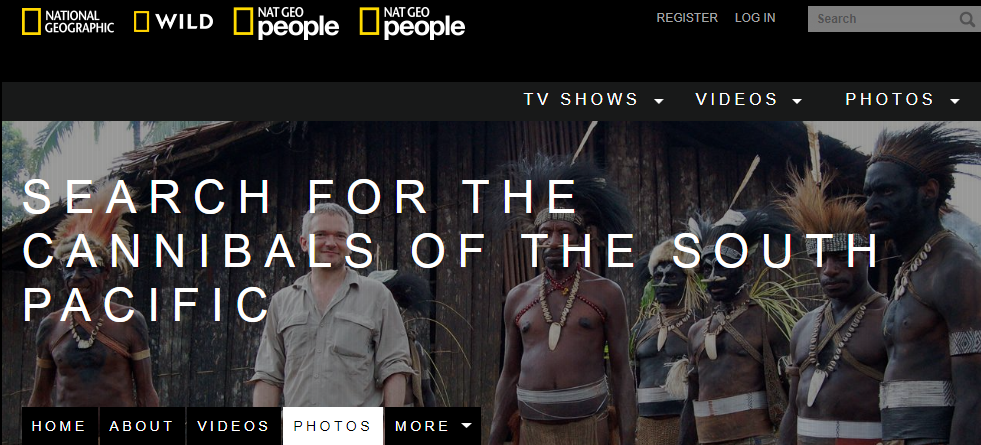
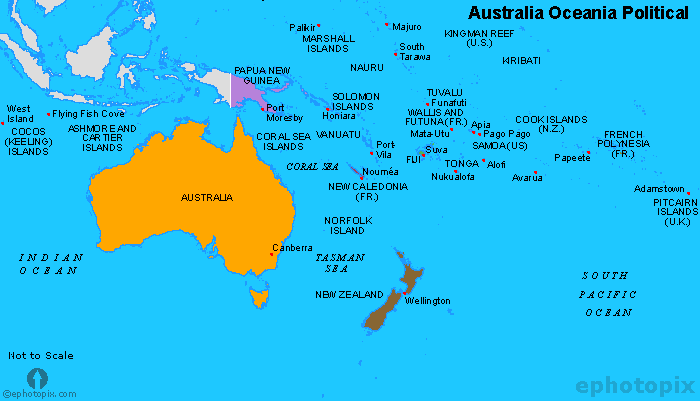

Dont subscribe or conject cannibalism on to primitive tribes protected in the Amazon rain forest…Who knows what they did or they do…as noted in this blog.
Indigenous cannibalism: look no further than the MOHAWKS which we ALGONQUINS know about all too well. on the west coast the KWAKIUTL people had their Hamatsa society.
Along with other researchers, they have identified 18 occurrences of cannibalism, nine of which occurred between about AD 1150 and 1200 in the Mesa Verde area. Once environmental conditions improved after 1200, there is little indication of cannibalism in the Southwest.
https://www.jstor.org/stable/2694812?seq=1
&
Christy Turner of Arizona State University, 1999 book, Man Corn, documents evidence of 76 different cases of prehistoric cannibalism in the Southwest that he uncovered during more than 30 years of research. Turner developed six criteria for detecting cannibalism from bones:
the breaking of long bones to get at marrow,
cut marks on bones made by stone knives,
the burning of bones,
“anvil abrasions” resulting from placing a bone on a rock and pounding it with another rock,
the pulverizing of vertebrae, and
“pot polishing”—a sheen left on bones when they are boiled for a long time in a clay vessel.
To strengthen his argument, Turner refuses to attribute the damage on a given set of bones to cannibalism unless all six criteria are met.
https://www.smithsonianmag.com/history/riddles-of-the-anasazi-85274508/
None of the other 1200 Native American cultures engaged in culturally sanctioned cannibalism at the time of European contact. That doesn’t mean cannibalism never happened–there were certainly stories in the American Indian oral history about cannibalistic incidents (a hunting party trapped in a snowstorm who fell to eating each other, a war chief who taunted captives by striking them in the face with their leader’s heart and then taking a bite out of it.) Cannibalism should not be considered part of American Indian culture on this account any more than it would be considered part of European or American culture–it was culturally unacceptable behavior.
The Sioux considered cannibalism a sin, the Cree considered it a mental illness, the Algonquin and Ojibwe considered it a sign of possession by an evil spirit.
In almost all cases, American Indian cannibals–just like European or American cannibals–were put to death as soon as they were discovered.
I think I’ll stay home and read while I eat my BLT, thanks.
I’m with you, Carolyn. I’m not going over there either – no intention of becoming Papuan New Guinea fast food.
Noted in YOUR article:
Then, there are primitive tribes protected in the Amazon rain forest. Who knows what they did or they do.
Survival director Stephen Corry said: “These loathsome remarks indicate the extent of racism against tribal peoples among some of the most powerful people in Brazilian society. It’s important that people both within and outside of Brazil are aware of the prevalence of these attitudes because they underpin the genocidal onslaught of violence that Brazilian tribes face today. That’s why we’ve decided to make Furtado Racist of the Year 2015.”
https://www.survivalinternational.org/news/11058
https://harvardpolitics.com/culture/uncontacted/
it is often the indigenous Brazilians who receive the least attention, but who are most endangered by this sort of bigotry. At best, anti-indigenous racism has produced apathy toward Brazil’s struggling indigenous populations. At worst, it incites violence — even today, racism continues to legitimize the extermination of the country’s Amazonians.
For Brazil’s native groups, violence has become commonplace. Rather than stepping in to defend indigenous peoples, the Brazilian government has often kowtowed to a powerful ruralist lobby, leaving Amazonians to die at the hands of ranchers and cattle farmers. Since 1985, more than 1400 have been killed in native/ranchero land conflicts.
This violence is often barbaric. In 2011, a Catholic Missionary group reported that a native Amazonian girl — just eight years old — had been tied to a tree and burned alive by illegal loggers as part of a ceaseless effort to expel indigenous peoples from their lands. “We heard they laughed as they burned her to death,” said Luis Carlos Guajajaras, a local tribal leader, in an interview with The Telegraph.
But to benefit from the lessons that the world’s indigenous populations offer, we must first move beyond the anti-indigenous bigotry that has proved so harmful throughout history. And in Brazil, the upcoming presidential election puts anti-indigenous enmity in the spotlight with candidate Jair Bolsonaro, who once told a Brazilian newspaper, “it is a shame that the Brazilian cavalry has not been so efficient as the Americans which exterminated the Indians.” If elected, he promises not to further demarcate “another centimeter” of the Amazon for tribespeople.
https://congressoemfoco.uol.com.br/especial/noticias/bolsonaro-quilombola-nao-serve-nem-para-procriar/
http://www.ohrc.on.ca/en/under-suspicion-issues-raised-indigenous-peoples
The Phantom of Racism
Racism and Indigenous Peoples
“Racism has historically been a banner to justify the enterprises of expansion, conquest, colonization and domination and has walked hand in hand with intolerance, injustice and violence.”
https://www.un.org/WCAR/e-kit/indigenous.htm
Genocide of indigenous peoples in Brazil
The process that has been described as the genocide of indigenous peoples in Brazil began with the Portuguese colonization of the Americas, when Pedro Álvares Cabral made landfall in what is now the country of Brazil in 1500.
This started the process that led to the depopulation of the indigenous peoples in Brazil, because of disease and violent treatment by European settlers, and their gradual replacement with colonists from Europe and Africa.
This process has been described as a genocide, and continues into the modern era with the ongoing destruction of indigenous peoples of the Amazonian region.
Over eighty indigenous tribes were destroyed between 1900 and 1957, and the overall indigenous population declined by over eighty percent, from over one million to around two hundred thousand.
The 1988 Brazilian Constitution recognizes indigenous peoples’ right to pursue their traditional ways of life and to the permanent and exclusive possession of their “traditional lands”, which are demarcated as Indigenous Territories.
https://en.wikipedia.org/wiki/Genocide_of_indigenous_peoples_in_Brazil
https://en.wikipedia.org/wiki/Indigenous_territory_(Brazil)
A shift is taking place in Brazil away from conservation of the Amazon and protection of Indian Nations. During the six years prior to the election of current President Dilma Rousseff, the government moved to conserve the Amazon rain forest, reducing deforestation by 80% by regulation supported by police raids of illegal cutting, and setting aside about 150 million acres of forest for conservation. Since the election of the new President in late 2010, the government has been granting more flexibility on environmental licensing for large infrastructure projects, and a provisional measure allows the President too remove forest from protection. Also, there is a proposal to give the Congress a veto over the recognition of Indigenous territories (Alexei Barrionuevo, “In Brazil, Fears of a Slide Back for Amazon Protection,” The New York Times, January 25, 2012). Brazil’s Congress, following lobbying by major agricultural groups, passed a bill, in late May 2012, that would have opened up large protected areas of the Amazon rain forest to deforestation for agricultural development. However, on May 24 President Dilma Rousseff vetoed 12 articles of the bill’s new Forest Code, a bill drafted to open big areas of protected forests to large-scale agriculture, including a provision that effectively granted amnesty to landowners who illegally deforested some areas.
https://www.nytimes.com/2018/09/26/opinion/amazon-climate-change-deforestation.html
Why this change in policy? The scientists put it succinctly: “In exchange for political support, the Brazilian government is signaling landholders to increase deforestation.”
President Temer’s minister of justice is pushing plans to allow agribusiness to rent indigenous land that had been off limits to developers. Other proposals would effectively freeze the creation of new protected areas, open others to resource exploitation and block the mapping of boundaries of indigenous lands, potentially opening native communities and their forests to invasion by miners and ranchers.
Indigenous territories contain more forest than all of the government’s conservation units combined, and historically Brazil’s native peoples have been far more effective in defending the rain forest than the government or private landowners.
primitive tribes protected in the Amazon rain forest…
https://www.survivalinternational.org/tribes/brazilian
Staple crops such as manioc, sweet potato, corn, bananas and pineapples are grown in gardens. Animals such as peccaries, tapir and monkeys, and birds like the curassow are hunted for meat.
Some tribes, like the Matis, use long blowguns with poisoned darts to catch prey. Most use bows and arrows, and some also use shotguns. Nuts, berries and fruits such as açai and peach palm are regularly harvested and bees’ honey is relished.
Fish, particularly in the Amazon, is an important food. Many indigenous people use fish poison or timbó to stun and catch fish. The Enawene Nawe, who do not eat red meat, are renowned for the elaborate wooden dams called ‘waitiwina’ which they build across small rivers every year to catch and smoke large quantities of fish. Their Yãkwa ceremony is linked to the fishing dams and has been recognized as part of Brazil’s national heritage.
A handful of peoples – the Awá, the Maku in the north-west and some uncontacted tribes – are nomadic hunter-gatherers. They live in small extended family groups and keep few possessions, which allows them to move rapidly through the forest. They can erect shelters from tree saplings and palm leaves in just a few hours.
Like all indigenous peoples, they carry incredibly detailed mental maps of the land and its topography, fauna and flora, and the best hunting places. The Awá sometimes hunt at night using torches made from the resin of the maçaranduba tree.
https://www.nationalgeographic.com/magazine/2018/10/isolated-brazil-peru-amazon-tribes-remote-protected/
https://wwf.panda.org/knowledge_hub/where_we_work/amazon/about_the_amazon/people_amazon/
Q: What do they find to eat?
A: Besides hunting, gathering wild fruits and nuts and fishing, Indigenous people also plant small gardens for other sources of food, using a sustainable farming method called shifting cultivation. First they first clear a small area of land and burn it. Then they plant many types of plants, to be used for food and medicines. After a few years, the soil has become too poor to allow for more crops to grow and weeds start to take over. They then move to a nearby uncleared area. This land is traditionally allowed to regrow for 10-50 years before it is farmed again. Shifting cultivation is still practiced by those indigenous groups who have access to a large amount of land. However, with the growing number of non-indigenous farmers and the shrinking rainforest, other groups, especially in Indonesia and Africa, are now forced to remain in one area. The land becomes a wasteland after a few years of overuse, and cannot be used for future agriculture.
https://www.adventure-life.com/amazon/articles/indigenous-people
Thanks for posting this information on the state of indigenous people in the Amazon region, Donna. You certainly seem knowledgeable and passionate about them.
Garry, thanks for all the gruesome details…I think.
Cannibalism is somewhat self-limiting b/c it causes kuru, a prion disease similar to mad cow disease or chronic wasting disease. Not a fun final illness. That may be why cannibalism is in decline.
I remember reading something about dangerous side effects from cannibalism, Debbie. Remind me not to try finding out in person.
I’ll meet you there! If I’m late, there’s no need to wait. I would hate to delay the utterly fascinating research trip. 😉
Okay. But I’m not sticking my neck out for you 🙂